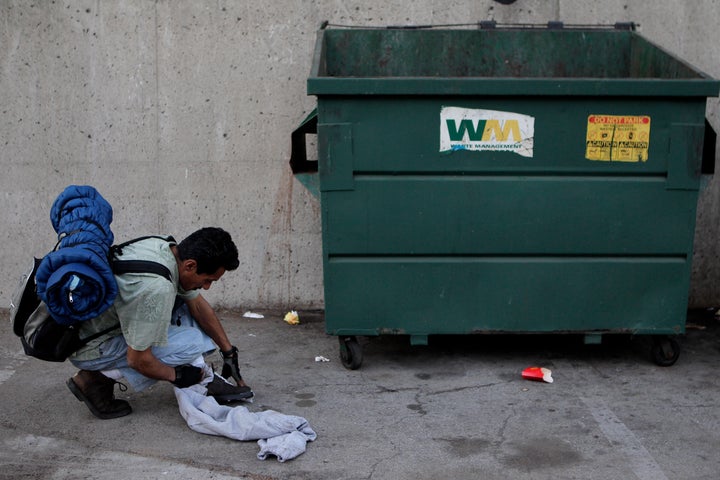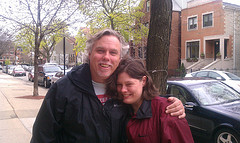
This is the fourth installment of the Impact series, #SocialGoodStars. The people highlighted here are passionate, dedicated philanthropists, strengths to their communities, and social media masters. They also happily share their vast knowledge with others, making them shine as leaders in the Social Good world. You can read the third interview with Amanda Hite here.
"Appreciation is a wonderful thing. It makes what is excellent in others belong to us as well." ~ Voltaire
Appreciation. When you think about Mark Horvath, it describes both the feeling one gets upon meeting him and hearing his tales, and also his compassionate view of the world. Through his documentation of the fascinating, sometimes heartbreaking, often inspiring, and always enriching stories of people experiencing homelessness in their own words, he helps us all gain a new appreciation of humanity and how similar we all really are. He's broken the mold. He is not doing what makes sense, he's not doing something that even pays the bills--he is living out his passion and doing what burns deep inside of him. Mark gives a face and a voice to homelessness, something he knows all too well as he once lived among them.

Mark Horvath with Ann Marie (@padschicago).
How did social media influence your decision to travel the US and
Canada for invisiblepeople.tv, interviewing our homeless friends and
the compassionate people and nonprofits that support them?
Seventeen years ago, I had a very good job in the television industry. Sixteen years ago, I became homeless, living on Hollywood Boulevard. I rebuilt my life to a point where I had a three-bedroom house and a 780 credit score, then in 2007 the economy took a nosedive. Like many Americans, I found myself unemployed, living off my credit cards, and hoping for the best. The best never came, but several layoffs -- along with foreclosure on my house -- did.
By November 2008, I found myself once again laid off. I was mentally and emotionally exhausted and, to be honest, I was scared of once again living on the streets of Hollywood. I could see homelessness all around me, but I couldn't bear to look.
I was turning away because I felt their pain.
Don't waste a good crisis. It's a simple concept and it's how InvisiblePeople. tv started. For the most part I had lost everything but some furniture, my car, a box of photos, laptop, small camera, and my iPhone. After looking at what I didn't have and all the problems that were stopping me, I decided to just use what I had. I registered a domain, changed the header on a WordPress theme, grabbed my camera, and started to interview people.
I honestly didn't think anyone would even view the videos. I was really doing it to release something that was deep down inside me, and to be candid, to keep busy. It was a really dark time and InvisiblePeople.tv gave me a purpose.
I'll never forget going into the first tent city. It was 400 yards in a wooded area where no help could easily arrive if I found myself in trouble. I questioned my sanity walking in there with a camera and a bag of socks. One smart thing I did was blast what I was doing all over social media so people could feel like they were right there with me. That day my life changed. People started to tweet me encouragement and all kinds of support. The InvisiblePeople. tv road trip was born.
What are some of your most memorable moments from your 2011 US/Canada Road Trip?
Getting to hang with Donnie in his apartment was a very powerful moment. It was so cold when I met Donny I thought my face was going to fall off. Donny had been homeless over twenty years. He had nothing but a blanket and the heating vent from a local business to stay warm. I honestly don't know how he survived. Thanks to the power of social media and Youtube, the people of Calgary targeted Donny and got him into housing.
Terry Pettigrew was a sweet man dying of cancer I first met while visiting a homeless shelter in Calgary, Canada. I was really moved by Terry and put his video up that very night. The local news media was with me when I visited Terry and The Calgary Herald put his story on their front page. Terry's brother, Larry, who he had no contact with for 34 years, saw the news story and the two brothers were reunited. There are no words to describe this miracle. I am so very grateful to have played a small part in Terry being reunited with his family for his last moments on Earth. Although homeless most of his life, Terry was able to spend 53 wonderful days with a loving family.
What also has me excited is the history we made with major brands and fighting homelessness this year. General Motors, Hanes, and Murphy USA, all had branded events in 2011 that helped benefit local homeless services, and this year, with @home being released, we will use what we learned in 2011 to hold events that are even bigger and will have more impact.
What advice would you give to someone who was looking to elevate their
social good efforts with social media?
Relationships are key. Story is everything. Communication is vital. Be flexible. Slow is good. Learn to be comfortable with insecurity.
There have been a lot of articles noting how important social media
and technology is to homeless people, to stay connected. Can you talk
a little about that? How did that influence WeAreVisible.com?
If you own a business, you better listen to your customers or you will go out of business. In homeless services, governments and nonprofits don't listen to the people we serve as much as we might. The general public has received most of its homeless information from marketing materials. We don't necessarily need another "expert" on homelessness... we need to listen to the single mom living in her van.
Social media can also provide much needed peer-to-peer support to homeless people and formerly homeless people. Most nonprofits do not have the resources to provide tangible social interaction with their clients. We cannot just throw people into housing. There must be community. Social norms are very powerful. We hope to launch the second phase of We Are Visible in early 2012 to help facilitate more social support.

You can learn more about the two organizations Mark Horvath founded at InvisiblePeople.tv and WeAreVisible.com. Follow Mark on Twitter @hardlynormal.
Amy Neumann is a writer, speaker and consultant on social good marketing. Check out her CharityIdeasBlog and follow her on Twitter @CharityIdeas

